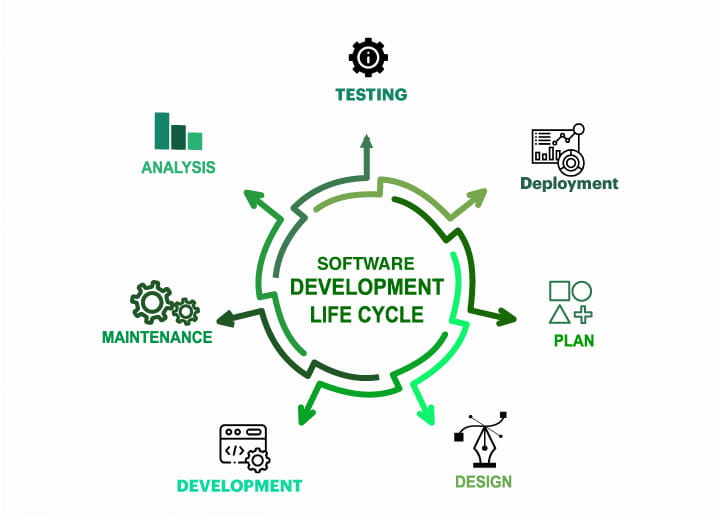Product Development Life Cycle (PDLC) and Software Development Life Cycle (SDLC) are approaches used to manage the process of generating and delivering software products and are important for the success of a software development project. Both PDLC and SDLC provide a framework for managing the many stages of software development, from concept through release.
In today’s world, the software development industry is a fast-paced and ever-evolving field that plays a crucial role in shaping the future of technology. From developing cutting-edge mobile apps to powering the cloud infrastructure that supports modern businesses, software developers are at the forefront of innovation. As the demand for technology
continues to grow, the software development industry is becoming increasingly important, providing exciting career opportunities for those with the necessary skills and expertise.
Therefore, implementing the methodologies of Product Development Life Cycle (PDLC) & Software Development Life Cycle (SDLC) plays an important role to ensure that projects operate smoothly and give a seamless solution to users is all that matters. In this article, we will learn about the procedures and processes that go into PDLC and SDLC, as well as how it emphasizes the current trends, challenges, and opportunities in this dynamic sector.
Checklist
PDLC & SDLC: What’s the difference?
According to a survey by the Standish Group, projects that follow a defined methodology such as SDLC or PDLC are more likely to be successful. The survey found that projects that followed a methodology had a 31% success rate, compared to just 14% for projects that did not follow a methodology. Agile methodology is the most widely used since it has been shown to produce measurable and consistent results for project success.
Additionally, Gartner, a leading research and advisory company, found that organizations that have a defined and repeatable product development process are more likely to be successful in the market. Moreover, they are trained and have the skills to use the most popular software development tools as well.
SDLC and PDLC are often used together, with PDLC providing the overall direction for the project, and SDLC providing the detailed plan for developing the software.

For more clarification, let us look at the table where we have compared the Software Development Life Cycle (SDLC) and Product Development Life Cycle (PDLC):
| Software Development Life Cycle (SDLC) | Product Development Life Cycle (PDLC) |
| SDLC focuses on the technical aspects of software development. | PDLC focuses on the overall process of bringing a new product to market. |
| SDLC includes the steps of planning, analysis, design, development, testing, deployment, and maintenance. | PDLC consists of identifying a problem or opportunity, conducting market research, defining product requirements, creating a prototype, testing, and launching the final product. |
| SDLC’s key goal is to create a high-quality software product that meets the requirements defined in the planning phase and is delivered on time and also within the allocated budget. | PDLC’s key goal is to create a product that meets the needs of the customer and is profitable for the company. |
| It provides a framework for ensuring that the software is developed to a high standard and is delivered on time and within budget. | It provides a framework for ensuring that the product meets customer needs and is profitable for the company. |
Steps in Software Development Life Cycle (SDLC):
“A good software project plan is like a roadmap: it helps you to know where you’re going, how to get there, and what to do when you arrive.“
– Anonymous
Every software development project necessitates meticulous preparation of when milestones will be met. It allows the project to succeed and improves its quality. As stated, a roadmap is crucial for knowing where you’re heading; you’ll be more conscious and competent.
You may be doing different types of software development, but the SDLC methodology is universal. For the seamless collaboration between teams there are various project management tools available as well, including Confluence, Bitrix24, Jira, and many others.

Let us look at the steps and understand the process followed during a SDLC:
1. Planning
The team assigned to the project defines the goals, objectives, and requirements for the software. This includes identifying the project scope, defining the target market, and creating a project plan.
2. Analysis
The team then conducts a thorough analysis of the project requirements. This includes identifying any potential constraints or risks, and determining the feasibility of the project.
3. Design
The team creates a detailed design for the software. This includes creating a system architecture, designing the user interface, and creating a detailed plan for the development process.
4. Development
Development phase is the most crucial, it is where the actual coding and development of the software takes place. The project team writes the code, tests it, and integrates it into the system.
Software developers may use tools like Zapier, Heroku, Pipefy, and many more.
5. Testing & QA
Testing is essential for any software system to mitigate the bugs and quality assurance ensures your product has the true potential to serve its purpose. In this stage the development team tests the software to ensure that it meets the requirements defined in the planning stage and that it is free of bugs or errors.
6. Deployment
The product or the software system is deployed to the end-users, in this stage. This includes installing the software on the target systems, configuring it, and providing training to the end-users.
7. Maintenance
After the software is deployed, the project team is responsible for maintaining it. This includes providing support, troubleshooting any issues that arise, and making any necessary updates or improvements to the software.
Overall, the aforementioned procedures are essential factors for a software development company or a software developer to perform during the development stage. As a result, quality and a smooth development cycle are ensured.

Steps in Product Development Life Cycle (PDLC):
From fundamental ideas and objectives, the Product Development Life Cycle (PDLC) is the process of defining, designing, developing, manufacturing, launching, and managing a product.
It is a guide for the proper management of your product and PDLC also provides a guide to calculate the cost, potential, and success of your idea behind the product.
For a more detailed understanding, let us look at the necessary steps followed during a product’s development:
1. Idea Generation
It is the first phase in the Product Development Life Cycle (PDLC), and it refers to the process of identifying an opportunity or a problem and coming up with ideas for a new product that addresses it. This stage is critical because it establishes the overall direction of the product development process.
2. Market Research
Marketing analysis is the most important stage, it ensures how your idea can be different from the rest and how it may help the users. Therefore, the team conducts market research to determine the feasibility of the product idea, that includes researching the target market, identifying potential customers, and determining the size of the market.
3. Concept Development
In this stage, the team develops a detailed concept for the product, that includes defining the product’s features, benefits, and its target market.
4. Business Analysis
The team conducts a thorough analysis of the product’s potential profitability. Starting from creating a business plan, identifying potential revenue streams, and determining the product’s break-even point.
5. Product Design
Creating a detailed design for the product is essential for its success. Therefore, forming a product architecture, designing the user interface, and creating a detailed plan for the development process helps understanding the product’s purpose.
6. Prototyping
The team creates a working prototype of the product, which allows the team to test the product’s design and gather feedback from potential customers. This ensures that the product is catering to the needs that it aims to fulfill.
Prototyping could be done using the mentioned tools: Figma, AdobeXD, Origami Studio, and many more.
7. Product Development
After all the thorough analysis and understanding, the team develops the final product following the necessary steps. This includes developing the product, deploying it, and creating any necessary documentation.
8. Product Launch
After it has been developed, the product is launched to the market and its consumers. This includes creating a marketing plan, and promoting the product to potential customers.
9. Post-Launch Review
After the launch, your team will conduct a review of the product’s performance in the market. This includes gathering feedback from customers, analyzing sales data, and making any necessary adjustments to the product.
Let’s Wrap it Up!
Software development companies must be able to quickly react to changing market conditions and consumer expectations in today’s fast-paced business climate.
In this blog, I have compared the SDLC and PDLC in a clear and comprehensive manner, to emphasize the fundamental distinctions between the two frameworks and how they can be utilized to help an organization’s software development efforts.
Overall, I have ensured to provide a thorough understanding of the SDLC and PDLC and how they differ in their approach to software development, whether custom software development or mobile app development. To thrive in the software development sector, it is critical to keep up with current trends and situations.
Frequently Asked Questions (FAQs)
1. Is SDLC a waterfall or Agile?
Agile and Waterfall are both extensively used Software Development Lifecycle (SDLC) approaches in the IT industry. The Waterfall framework was created to allow for a disciplined and deliberate procedure for establishing high-quality information systems within the limits of a project.
2. Is agile a product development?
The process of creating a product using the Agile methodology is referred to as agile product development. Agile product development divides the project into small development cycles known as sprints. Product teams present a working product to consumers after each iteration in order to gather feedback and make changes as needed.
3. What does the 4 P’s of marketing mean?
The four P’s of marketing are a marketing concept that highlights the four most important aspects of every marketing strategy. Product, pricing, place, and promotion are the four Ps.
4. What are the 2 types of SDLC models?
The two primary software development life cycle models are heavyweight (predictive) and lightweight (agile).


